Tanganjika |
|
|
|
| Übersicht – Contents: | |
Diese Seite ist Teil des Projektes
Tanganjika |
|
|
|
| Übersicht – Contents: | |
Flagge – Flag: |
|
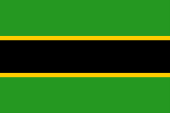 |
1961–1964, Nationalflagge – national flag, Seitenverhältnis – ratio = 2:3, Quelle/Source, nach/by: Flags of the World |
historische Flaggen – historical Flags: |
|
 |
1885–1895, Flagge der Deutsch-Ostafrikanischen Gesellschaft (DOAG) – flag of the German East African Company (DOAG), Seitenverhältnis – ratio = 2:3(?), Quelle/Source, nach/by: Flags of the World |
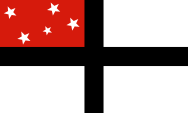 |
1895–1920, Flagge der Deutsch-Ostafrikanischen Gesellschaft (DOAG) – flag of the German East African Company (DOAG), Seitenverhältnis – ratio = 3:5, Quelle/Source, nach/by: Flags of the World |
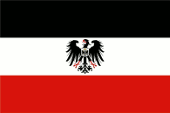 |
1898–1919, Flagge des Gouverneurs der Kolonie Deutsch-Ostafrika – flag of the Governor of German East Africa, Seitenverhältnis – ratio = 2:3, Quelle/Source, nach/by: Flags of the World |
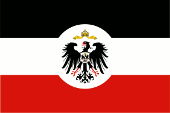 |
1892–1919, Deutsches Reich – German Empire, Dienstflagge Kolonialamt / Auswärtiges Amt – Official flag colonial office / foreign office, Seitenverhältnis – ratio = 2:3, Quelle/Source, nach/by: Flags of the World |
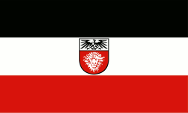 |
1914, geplante Flagge für Deutsch-Ostafrika – planned flag for German East Africa, Seitenverhältnis – ratio = 3:5, Quelle/Source, nach/by: Flags of the World, Flag Reconstruction following Mark Sensen (Feb 98) based on traditional interpretation from Afrika-Nachrichten article 1933 |
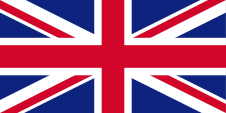 |
1919–1961, Union Flag → quasi Nationalflagge, Flagge Großbritanniens – flag of United Kingdom, Seitenverhältnis – ratio = 1:2, Quelle/Source, nach/by: Flags of the World   |
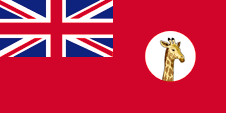 |
1919–1961, Handelsflagge – merchant flag, Seitenverhältnis – ratio = 1:2, Quelle/Source, nach/by: Flags of the World |
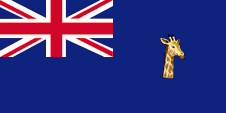 |
1919–1961, Flagge der Regierung (Staatsflagge) – flag of the government (state flag), Seitenverhältnis – ratio = 1:2, Quelle/Source, nach/by: Flags of the World |
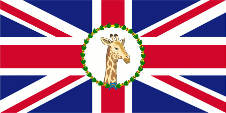 |
1919–1961, Flagge des Gouverneurs – flag of the Governor, Seitenverhältnis – ratio = 1:2, Quelle/Source, nach/by: Flags of the World |
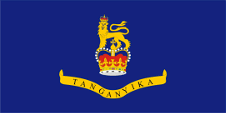 |
1961–1962, Flagge des Generalgouverneurs – flag of the Governor General, Seitenverhältnis – ratio = 1:2, Quelle/Source, nach/by: Flags of the World |
|
Die Flagge Tanganjikas ging auf die Flagge der TANU-Partei zurück. Sie wurde
anlässlich der Unabhängigkeit im Jahre 1961 geschaffen, indem auf der
TANU-Flagge schmale gelben Trennstreifen zwischen Schwarz und Grün eingefügt
wurden. Als Sansibar sich mit Tanganjika zu Tansania zusammenschloss wurden
die Flaggen beider Länder zur heutigen Nationalflagge von Tansania
verschmolzen. Unter der Verwaltung der Deutsch-Ostafrikanischen Gesellschaft (1885–1890) wurde die Flagge dieser Organisation verwendet. Die 1885 geschaffene Flagge war weiß mit einem roten Mittelfeld, das durch schwarze, jedoch bis zum Rand der Flagge reichende Doppellinien vom weißen Rand getrennt war. Im roten Mittelfeld erschien in Weiß eine stilisierte Landschaft mit einem Löwen, einer Palme und den fünf Sternen des Kreuzes des Südens. Die Ecken der Flagge zeigten vier schwarze gemeine, griechische Kreuze mit gleich langen Balken. Im Jahre 1895 wurde eine neue Flagge für die Gesellschaft eingeführt. Sie wird Carl-Peters-Flagge oder Petersflagge genannt, nach Carl Peters, dem Gründer von Deutsch-Ostafrika. Diese Flagge war weiß mit einem durchgehenden schwarzen Balkenkreuz und einer roten Oberecke, die mittels fünf weißer Sterne das Sternbild des "Kreuz des Südens" anzeigte. Als deutsche Kolonie verwendete das Land ab 1890 keine besondere Nationalflagge. Es galten die Farben des Deutschen Reiches: Schwarz, Weiß und Rot. Behörden verwendeten die Flagge des Kolonialamtes sowie Abarten davon. Diese war zwar schwarz, weiß und rot waagerecht gestreift und zeigte in der Mitte eine weiße Scheibe mit dem Reichsadler. Ab 1913 wurde überlegt, für die Kolonien eigene Hoheitszeichen zu schaffen. Erste Entwürfe lagen 1914 vor, jedoch wurde das Projekt wegen des Ausbruchs des Ersten Weltkriegs und wegen des Verlusts der Kolonien nicht mehr realisiert. Nachdem Tanganjika nach dem Ende des Ersten Weltkrieges und in Folge des Versailler Diktats als Mandatsgebiet Völkerbunds unter britische Verwaltung gestellt worden war, wurde das britische Flaggensystem mit einem "Blue Ensign" und einem "Red Ensign" eingeführt, ein rotes und ein dunkelblaues Flaggentuch mit einer Flaggendarstellung – dem britischen Union Jack – in der Oberecke. Der Union Jack wies auf die Verbindungen zu Großbritannien hin. Großbritannien hatte in Jahr 1864 ein Flaggensystem eingeführt, in dem: • Kriegsschiffe einen sogenannten "White Ensign" (Marineflagge), eine weiße Flagge oft mit durchgehendem roten Georgskreuz und mit dem Union Jack in der Oberecke, • Handelsschiffe einen "Red Ensign" (auch "Civil Ensign" → Bürgerflagge genannt, die eigentl. Handelsflagge), eine rote Flagge mit dem Union Jack in der Oberecke, und • Dienstschiffe einen "Blue Ensign" (Regierungsflagge → die eigentl. Staatsflagge), eine blaue Flagge mit dem Union Jack in der Oberecke führten. Seit 1865 durften Schiffe von Kolonialregierungen einen Blue Ensign mit einem Badge (Abzeichen) im fliegenden Ende führen. Die jeweiligen Regierungen sollten entsprechene Bagdes zur Verfügung stellen. Handelsschiffe und seefahrende Privatpersonen aus Kolonien dürfen nur dann einen Red Ensign mit Badge führen, wenn von der britischen Admiralität eine entsprechende Erlaubnis für die Kolonie erteilt wurde. Diese Erlaubnis war Tanganjika erteilt worden, so dass ein "Red Ensign", ein rotes Flaggentuch mit dem britischen Union Jack in der Oberecke und dem Badge der Mandatsverwaltung als Handelsflagge verwendet werden konnte. Das Badge war ein Giraffenkopf, der nur auf dem Red Ensign auf einer weißen Scheibe dargestellt wurde. Ein solches Badge war bei britischen Kolonien oft eine auf einer Scheibe platzierte regionale landschaftliche Darstellung, zeigte oft Schiffe, historische Begebenheiten oder konnte auch nur eine Art Logo sein. Sehr oft zeigte ein Badge zusätzlich den Namen des Landes oder auch einen Wahlspruch. Einige Besitzungen hatten aber auch schon von Anfang an ein Wappen, bzw. erhielten über die Jahre eine eigenes Wappen und das Badge wurde abgeschafft. Um ein weitgehend einheitliches Erscheinungsbild im fliegenden Ende der Flaggen zu gewährleisten, wurden Wappen und auch andere Symbole auf einer weißen Scheibe in der Größe der früheren Badges dargestellt. Es gab hier aber auch Ausnahmen, denn einige Kolonien verwendeten diese weiße Scheibe nicht, und platzierten ihr Wappen oder auch nur das Wappenschild – manchmal auch vergrößert – direkt auf das Flaggentuch. Schon in den 40-er Jahre wurde dazu übergegangen die weiße Scheibe zu entfernen und das Wappen direkt zu platzieren oder vergrößert dazustellen. Dieser Umstellungsprozess erfolgte allmählich, nirgendwo gleichzeitig und vollständig. In einigen britischen Besitzungen sind bis heute Flaggen mit der weißen Scheibe in Gebrauch, in anderen nicht mehr und in einigen Gebieten gibt es beide Varianten nebeneinander. |
The flag of Tanganyika was based on the flag of the TANU party. It was
created on the occasion of independence in 1961 by adding narrow yellow
dividing stripes between black and green on the TANU flag. When Zanzibar
merged with Tanganyika to form Tanzania, the flags of both countries were
merged to form the current national flag of Tanzania. Under the administration of the German East Africa Company (1885–1890), this organization's flag was used. The flag, created in 1885, was white with a red center field separated from the white edge by black double lines that extended to the edge of the flag. In the red center field, a stylized landscape appeared in white with a lion, a palm tree and the five stars of the Southern Cross. The corners of the flag showed four black Greek crosses with bars of equal length. In 1895 a new flag was adopted for the company. It is called the Carl Peters flag or Peter's flag, after Carl Peters, the founder of German East Africa. This flag was plain white with a continuous black bar cross and a red upper corner, which displayed the constellation of the "Southern Cross" using five white stars. As a German colony, the country did not use a special national flag from 1890 onwards. The colors of the German Empire were used: black, white and red. Authorities used the flag of the Colonial Office as well as variations of it. It was horizontally striped in black, white and red and showed a white disc with the imperial eagle in the middle. From 1913 onwards, consideration was given to creating their own national emblems for the colonies. The first drafts were available in 1914, but the project was no longer implemented due to the outbreak of the First World War and the loss of the colonies. After Tanganyika was placed under British administration as a mandated territory of the League of Nations after the end of the First World War and as a result of the Versailles Dictate, the British flag system was introduced with a "Blue Ensign" and a "Red Ensign", a red and a dark blue flag bunting with a Flag depiction – the British Union Jack – in the upper corner. The Union Jack indicated the connections to United Kingdom. United Kingdom introduced a flag system in 1864 in which: • war ships fly the "White Ensign" (naval flag), a white flag often with an uninterrupted red St. George's-Cross and with the Union Jack in the upper staff quadrant of the flag, • merchant ships fly a "Red Ensign" (also named "Civil Ensign" → civil flag, the real merchant flag), a red flag with the Union Jack in the upper staff quadrant of the flag, and • governmental ships fly the "Blue Ensign" (flag for the use by the gouvernment → the actual state flag), a blue flag with the Union Jack in the upper staff quadrant of the flag. Since 1865 ships of colonial governments were permitted to fly the Blue Ensign with a badge in the flying end of the flag. The respective governments were asked to design appropriate badges. Merchant ships and seafaring persons from colonies were only permitted to use the Red Ensign with a badge, then also named Civil Ensign, if permission has been given to the respective colony by the British admiralty. This permission had been granted to Tanganyika so that a "Red Ensign", a red flag bunting with the British Union Jack in the upper corner and the badge of the mandate administration, could be used as merchant flag. The badge was a giraffe head, which was only depicted on the Red Ensign on a white disc. Such a badge was often a regional landscape representation placed on a disk, often showing ships, historical events or even a kind of a logo. Very often, a badge also showed the name of the country or a motto. Some British possessions, however, already had a coat of arms from the beginning, or their badge was replaced by a coat of arms over the years. To ensure a uniform appearance in the flying end of the flags, coats of arms and other symbols were displayed on a white disk in the size of the earlier badges. There were also exceptions, because some colonies did not use the white disk and placed their escutcheon or even coat of arms directly on the bunting, sometimes enlarged. Already in the '40s they started to remove the white disk and placed the coat of arms directly or enlarged. This conversion process was done gradually, nowhere at the same time and completely. In some British possessions, flags with the white disc are still in use, in others no more and in some areas are both variants in use, next to each other. |
| Quelle/Source: 1.) Flags of the World, 2.) Flags of the World, Wikipedia (D), Die Welt der Flaggen, Volker Preuß | |
Wappen – Coat of Arms: |
|
 |
1914, geplantes Wappen von Deutsch-Ostafrika – planned coat of arms of German East Africa, Quelle/Source, nach/by: Flags of the World, Flag Reconstruction following Mark Sensen (Feb 98) based on traditional interpretation from Afrika-Nachrichten article 1933 |
 |
1919–1961, Emblem von Tanganjika – Badge of Tanganyika, Quelle/Source, nach/by: Flags of the World |
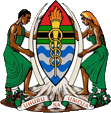 |
1961–1964, Wappen von Tanganjika – Coat of arms of Tanganyika, Quelle/Source, nach/by: Poohgun - junmon [Public domain], via Wikimedia Commons |
Bedeutung/Ursprung des Wappens – Meaning/Origin of the Coat of Arms: |
|
| Das Wappen der Republik Tanganjika, zeigte zwischen 1961 und 1964 einen Massai-Schild mit drei untereinander angeordneten Feldern, darin unter anderem die Nationalflagge von Tanganjika, und blaue Wellenlinien (Meer) und über allem eine Fackel (Freiheitsfackel). Schildhalter sind ein Bantu-Mann und eine Bantu-Frau, die beide einen Elefantenstoßzahn halten. Der Schild ruht auf dem Berg Kilimandscharo, links Kaffee- und rechts Baumwollpflanzen. Das Landesmotto steht in roten Buchstaben auf einem weißen Spruchband. Es ist in Suaheli und lautet: "Uhuru na Umoja" → "Freiheit und Einheit". Das Land war einst eine deutsche Kolonie. Die deutschen Kolonien unterstanden – Kiautschou ausgenommen – dem Reichskolonialamt. Entsprechend verwendeten Behörden dessen Siegel, Flaggen und das Reichswappen. Ab 1913 wurde überlegt, für die Kolonien eigene Hoheitszeichen zu schaffen. Erste Entwürfe lagen 1914 vor, jedoch wurde das Projekt wegen des Ausbruchs des Ersten Weltkriegs und wegen des Verlusts der Kolonien nicht mehr realisiert. Das gedachte Aussehen der Wappen und Flaggen konnte in den 20er und 30er Jahren des 20. Jahrhunderts anhand von Fragmenten lediglich rekonstruiert werden. Die meisten Rekonstruktionen beziehen sich auf einen Artikel der Zeitung "Afrika-Nachrichten" von 1933 und die daraus folgenden Rekonstruktionen des niederländischen Vexillologen Mark Sensen vom Februar 1998, die auch auf diesen Seiten berücksichtigt werden. Die Wappen der Kolonien sollten oberhalb des Wappenschilds noch die Kaiserkrone tragen, jedoch nicht auf den Flaggen, wenn man der Rekonstruktion von Mark Sensen folgt. Die Wappenschilde zeigten immer den gleichen Aufbau: Ein horizontal zweigeteiltes Schild, dessen Schildhaupt auf weiß den Reichsadler mit dem Brustschild des Hauses Hohenzollern zeigte. Im Hauptteil eine stilisierte Darstellung von Pflanzen, Tieren oder Landschaften, die je nach Land unterschiedlich gefärbt waren. Das geplante Wappen von Deutsch-Ostafrika zeigte einen weißen Löwenkopf auf rotem Grund. In seiner Zeit als britisches Mandatsgebiet hatte das Land ein eigenes Emblem, ein sogenanntes Badge, das Abzeichen der Mandatsverwaltung. Das Badge war ein Giraffenkopf, der nur auf dem Red Ensign auf einer weißen Scheibe dargestellt wurde. |
The coat of arms of the Republic of Tanganyika showed between 1961 and 1964
a Maasai shield with three fields arranged one below the other, including
the national flag of Tanganyika, and blue wavy lines (sea) and above all a
torch (freedom torch). Shield holders (supporters) are a Bantu man and a
Bantu woman, both holding an elephant tusk. The shield rests on Mount
Kilimanjaro, with coffee plants on the left and cotton plants on the right.
The state motto is written in red letters on a white banner. It is in
Swahili and reads: "Uhuru na Umoja" → "Freedom and Unity". The country was once a German colony. The German colonies – with the exception of Kiautschou (Kiaochow) – were subordinated to the Colonial Office of the German Empire. Accordingly, authorities used its seals, flags and the imperial coat of arms. From 1913 onwards, consideration was given to creating their own national emblems for the colonies. The first drafts were available in 1914, but the project was no longer implemented due to the outbreak of the First World War and the loss of the colonies. The intended appearance of the coats of arms and flags could only be reconstructed using fragments in the 1920s and 1930s. Most of the reconstructions refer to an article in the newspaper "Afrika-Nachrichten" from 1933 and the resulting reconstructions by the Dutch vexillologist Mark Sensen from February 1998, which are also included on these pages. The coats of arms of the colonies should bear the imperial crown above the escutcheon, but not on the flags, if one follows Mark Sensen's reconstruction. These heraldic shields always had the same structure: a horizontally divided shield, the head of which showed the imperial eagle on white with the breastplate of the House of Hohenzollern. The main part is a stylized representation of plants, animals or landscapes that were colored differently depending on the country. The planned coat of arms of German East Africa showed a white lion's head on a red background. During its time as a British mandate, the country had its own emblem, a so-called badge, the insignia of the mandate administration. The badge was a giraffe head, which was only depicted on the Red Ensign on a white disc. |
| Quelle/Source: Wikipedia (D), Wikipedia (EN), Volker Preuß | |
| Zahlen und Fakten – Numbers and Facts: | |
|
|
|
|
|
|
|
|
|
|
|
|
|
|
|
Antike
· Siedlungsgebiet der Bantu-Stämme 10. Jahrhundert · Eindringen des Islam entlang der Küste 975 · Gründung von Kilwa als arabischer Handelsstützpunkt 1499 · Vasco da Gama segelt auf dem Weg nach Indien entlang der Küste 1505 · Eroberung von Kilwa durch die Portugiesen, Inbesitznahme der gesamten Ostküste Afrikas 1698–1730 · die Küste Tanganjikas fällt an Oman 1856 · Tod des Sultans von Oman, in Folge britischem Drucks Teilung des Landes (Teilung der Dynastie in zwei Linien) in das Sultanat Oman und das Sultanat Sansibar, die Küste Tanganjikas kommt an Sansibar 17.02.1885 · Carl Peters erwibt im Namen der Deutsch-Ostafrikanischen Gesellschaft (DOAG) Territorien im Landesinneren vom Sultan von Sansibar 27.05.1885 · Errichtung des Protektorats Deutsch-Ostafrika einschließlich Deutsch-Witu (im heutigen Kenia gelegen) 28.04.1888 · die DOAG pachtet die Küste des Festlands vom Sultan von Sansibar 01.07.1890 · Helgoland-Sansibar-Vertrag, das Deutsche Reich verzichtet auf sein Protektorat über Sansibar, im Gegenzug Erwerb der Insel Helgoland von Großbritannien und die Abtretung von Deutsch-Witu an Großbritannien 20.11.1890 · die Verwaltung des Protektorats Deutsch-Ostafrika wird der DOAG nach Aufständen und Unruhen entzogen, Bildung der Kolonie Deutsch-Ostafrika 1896/1890 · Grenzverträge mit Großbritannien und Portugal 1914–1918 · Erster Weltkrieg (1916 · britische, indische, südafrikanische, belgische und portugiesische Truppen erobern Deutsch-Ostafrika, Widerstand der deutschen Schutztruppe bis zum 14.11.1918) 1918 · portugiesische Truppen besetzen das Ruvuma-Dreieck 1919 · Ruanda und Urundi kommen unter belgische Kontrolle 1920 · das Ruvuma-Dreieck wird an Portugal abgetreten (zu Portugiesisch-Ostafrika [Moçambique]) 20.07.1922 · Deutsch-Ostafrika wird unter dem Namen Tanganjika britisches Mandatsgebiet des Völkerbundes 11.12.1946 · Tanganjika wird britisches Treuhandgebiet der UNO 1954 · Gründung der TANU-Partei (Tanganyika African National Union), sie fordert die Unabhängigkeit des Landes 01.05.1961 · Großbritannien gewährt Selbstverwaltung 09.12.1961 · Großbritannien gewährt die Unabhängigkeit im Rahmen des Commonwealth of Nations 09.06.1962 · Gründung der "Republik Tanganjika" 27.04.1964 · die Volksrepublik Sansibar vereinigt sich mit der Republik Tanganjika zur "Vereinigten Republik von Tanganjika und Sansibar" 29.10.1964 · Umbenennung in "Vereinigte Republik Tansania" 1965 · Etablierung eines Einparteiensystems (TANU in Tanganjika, ASP in Sansibar) 1977 · TANU und ASP schließen sich zur CCM-Einheitspartei zusammen 1978 · Krieg mit Uganda 1992 · Ende des Einparteiensystems 2000 · Erstarken der Tanganjika-Nationalbewegung |
|
Antiquity
· settlement area of the Bantu tribes 10th century · invasion of the Islam along the coast 975 · foundation of Kilwa as Arabian trading base 1499 · Vasco da Gama sails along the coast on his way to India 1505 · conquest of Kilwa by the Portugese, appropriation of the whole eastern coast of Africa 1698–1730 · the coast of Tanganyika comes to Oman 1856 · death of the Sultan of Oman, in result of British pressure division of the country (division of the dynasty in two lines) in the Sultanate of Oman and the Sultanate of Zanzibar, the coast of Tanganyika comes to Zanzibar 17th of February 1885 · Carl Peters acquires places in the innards of the land in the name of the German East African Company (DOAG) from the Sultan of Zanzibar 27th of May 1885 · establishment of the protectorate of German East Africa including German Witu (situated in the today’s Kenya) 28th of April 1888 · the DOAG leases the coast of the mainland from the Sultan of Zanzibar 1st of July 1890 · Heligoland-Sansibar Treaty, the German Empire renounces its protectorate over Zanzibar, in countermove acquisition of the island of Heligoland from United Kingdom and the ceding of German Witu to United Kingdom 20th of November 1890 · the administration of the protectorate of German East Africa becomes taken away from the DOAG after riotings and agitations, formation of the colony of German East Africa 1896/1890 · frontier treaties with United Kingdom and Portugal 1914–1918 · First World War (1916 · British, Indian, South African, Belgian and Portuguese troops conquer German East Africa, resistance of the German protection troops until the 14th of November in 1918) 1918 · Portugese troops occupy the Ruvuma Triangle 1919 · Ruanda and Urundi come under Belgian control 1920 · the Ruvuma Triangle becomes ceded to Portugal (to Portugese East Africa [Moçambique]) 20th of July 1922 · German East Africa becomes a British mandate of the League of Nations with the name Tanganyikas 11th of December 1946 · Tanganyika becomes a trust territory of the UNO 1954 · foundation of the TANU party (Tanganyika African National Union), it claims the independence of the country 1st of May 1961 · United Kingdom grants self-administration 9th of December 1961 · United Kingdom grants independence in the framework of the Commonwealth of Nations 9th of June 1962 · formation of the "Republic of Tanganyika" 27th of April 1964 · the People’s Republic of Zanzibar unites with the Republic of Tanganyika to the "United Republic of Tanganyika and Zanzibar" 29th of October 1964 · rename in "United Republic of Tanzania" 1965 · establishment of a single-party-system (TANU in Tanganyika, ASP in Zanzibar) 1977 · TANU and ASP unite to the CCM unity party 1978 · war with Uganda 1992 · end of the single-party-system 2000 · growing of the Tanganyika national movement |
| Quelle/Source: Atlas zur Geschichte, Wikipedia (D), Discovery '97, Volker Preuß |
| Der Name "Tanganjika" bedeutet "Land der vielen Stämme". Daher hat auch der Tanganjika-See seinen Namen. In der Zeit als Deutsche Kolonie wurde der Name Deutsch-Ostafrika verwendet. Nachdem Deutsch-Ostafrika als Völkerbundsmandat an Großbritannien übergeben wurde, konnte der Name nicht in Britisch-Ostafrika abgeändert werden, weil bereits das heutige Kenia diesen Namen trug. Man besann sich wieder des alten Namens "Tanganjika". | The name
"Tanganyika" means "Land of the many tribes". From there has the Tanganyika
Lake its name too. In the times as German colony was used the name Deutsch-Ostafrika (German East Africa). After German East Africa was haded over to United Kingdom as a mandate of the League of Nations, the name could not be changed into British East Africa because already the today’s Kenya used that name. They remembered the old name "Tanganyika". |
| Quelle/Source: Handbuch der geographischen Namen, Volker Preuß | |